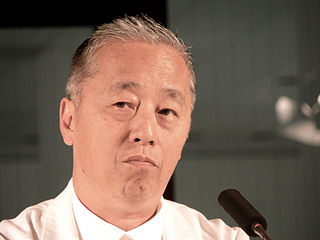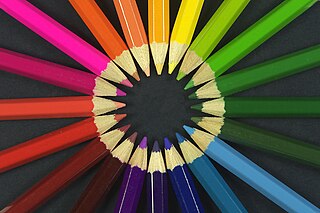
In visual arts, music and other media, minimalism was an art movement that began in post–World War II in Western art, and it is most strongly associated with American visual arts in the 1960s and early 1970s.

Monochromatic painting has played a significant role in modern and contemporary Western visual art, originating with the early 20th-century European avant-gardes. Artists have explored the non-representational potential of a single color, investigating shifts in value, diversity of texture, and formal nuances as a means of emotional expression, visual investigation into the inherent properties of painting, as well as a starting point for conceptual works. Ranging from geometric abstraction in a variety of mediums to non-representational gestural painting, monochromatic works continue to be an important influence in contemporary art.
Minimal music is a form of art music or other compositional practice that employs limited or minimal musical materials. Prominent features of minimalist music include repetitive patterns or pulses, steady drones, consonant harmony, and reiteration of musical phrases or smaller units. It may include features such as phase shifting, resulting in what is termed phase music, or process techniques that follow strict rules, usually described as process music. The approach is marked by a non-narrative, non-teleological, and non-representational approach, and calls attention to the activity of listening by focusing on the internal processes of the music.
The Hasselblad Award is an award granted to "a photographer recognized for major achievements".
Erstwhile Records is an independent record label devoted to free improvisation, particularly the electroacoustic variety, contemporary, experimental composed music, and combinations of both. Erstwhile was founded by Jon Abbey in 1999, whose personality and tastes are closely identified with the label.

Sandy Skoglund is an American photographer and installation artist. Her contributions to photography have advanced the medium as a form of conceptual art. She is well known for her intricately designed environments, which utilize painterly and sculptural techniques within staged and performative scenes. Photography critic Andy Grundberg notes that Skoglund's work contains "all the hallmarks of the new attitude toward photographs: they embrace blatant artificiality; they allude to and draw from an 'image world' of endless pre-existing photographs, and they reduce the world to the status of a film set."

Hiroshi Sugimoto is a Japanese photographer and architect. He leads the Tokyo-based architectural firm New Material Research Laboratory.

The term composition means "putting together". It can be thought of as the organization of the elements of art according to the principles of art. Composition can apply to any work of art, from music through writing and into photography, that is arranged using conscious thought.

Wedding photography is a specialty in photography that is primarily focused on the photography of events and activities relating to weddings. It may include other types of portrait photography of the couple before the official wedding day, such as a pre-wedding engagement session, in which the photographs are later used for the couple's wedding invitations. On the wedding day, the photographer(s) will provide portrait photography as well as documentary photography to document the different wedding events and rituals throughout the day(s).

The following outline is provided as an overview of and topical guide to the visual arts:

Nature photography is a wide range of photography taken outdoors and devoted to displaying natural elements such as landscapes, wildlife, plants, and close-ups of natural scenes and textures. Nature photography tends to put a stronger emphasis on the aesthetic value of the photo than other photography genres, such as photojournalism and documentary photography.
Lo-fi photography refers to unconventional photographic practices, chosen for aesthetics, which give an impression of low quality. Popular techniques include the use of toy cameras or pinhole cameras, for their distinctive stylistic effects. It can be considered a reaction to the perceived ease of creating technically perfect photos in the digital age. Some emphasize a return to film, while others use digital technology to accomplish the same effects. Low-fidelity photography has also been commonly linked with lo-fi music as well.
Richard Chartier is a sound/installation artist and graphic designer from the United States. He works in reductionist microsound electronic music, a form of extreme minimalism characterised by quiet and sparse sound.
Miyako Ishiuchi, is a Japanese photographer.

In the visual arts, texture refers to the perceived surface quality of a work of art. It is an element found in both two-dimensional and three-dimensional designs, and it is characterized by its visual and physical properties. The use of texture, in conjunction with other design elements, can convey a wide range of messages and evoke various emotions.

The diagonal method (DM) is a rule of thumb in photography, painting and drawing. Dutch photographer and lecturer Edwin Westhoff discovered the method when, after having long taught the rule of thirds in photography courses, he conducted visual experiments to investigate why this rule of thirds only loosely prescribes that points of interest should be placed more or less near the intersection of lines, rather than being rigid and demanding placement to be precisely on these intersections. Having studied many photographs, paintings and etchings, he discovered that details of interest were often placed precisely on the diagonals of a square, instead of any "strong points" that the rule of thirds or the photographic adaptation of the golden ratio suggests. A photograph is usually a rectangular shape with a ratio of 4:3 or 3:2, from which the diagonals of the photograph are placed at the bisection of each corner. Manually placing certain elements of interest on these lines results in a more pleasing photograph.
Mike Vensel is an American artist, photographer and fashion designer. His works explore ideas of simplicity, structure, fluidity, nature and form in various mediums including painting, drawing, sculpture, photography, video art, digital art, performance art and fashion design. Throughout all of his creative endeavors he maintains a sleek, sexy minimalist ecstatic that transcends the various mediums.
Geoffrey Farmer is best known for extensive multimedia installations made of cut-out images which form collages.

Hellen van Meene is a Dutch photographer known especially for her portraits.
Minimalist cinema is related to the art and philosophy of minimalism.

















